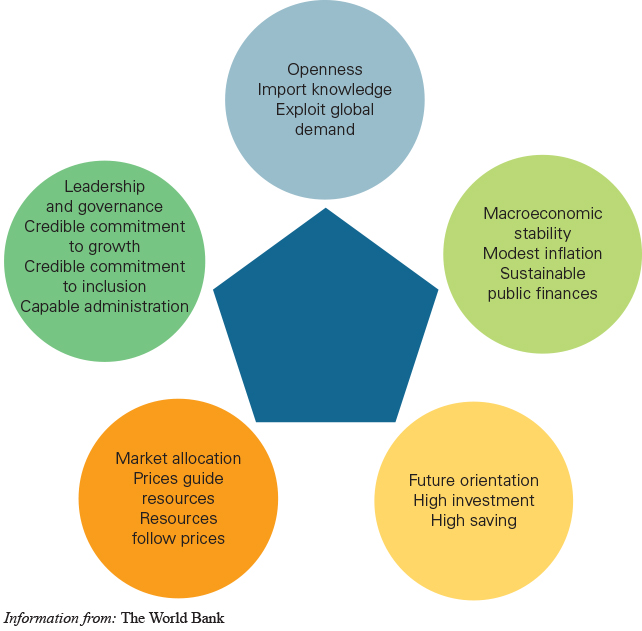Chapter 12. Is There a New Washington Consensus?
Discussion Questions
Chapter 12 HEADLINE: Is There a New Washington Consensus?
The following article discusses The Growth Report: Strategies for Sustained Growth and Inclusive Development—often referred to as the Spence report— the result of a World Bank commission to understand economic growth in developing countries, and determine what policymakers could do about it.
Two and a half years ago, senior staff members of the World Bank approached the Nobel laureate Michael Spence to ask him to lead a high powered commission on economic growth. The question at hand could not have been more important. The “Washington consensus”—the infamous list of do’s and don’ts for policymakers in developing countries—had largely dissipated. But what would replace it?
Spence was not sure he was the man for the job. After all, his research had focused on theoretical issues in advanced economies; he had been dean of a business school; and he did not have much experience in economic development. But he was intrigued by the task. And he was encouraged by the enthusiastic and positive response he received from the commission’s prospective members. Thus was born the Spence Commission on Growth and Development, a star-studded group of policymakers—including another Nobelist—whose final report was issued at the end of May.
The Spence report represents a watershed for development policy—as much for what it says as for what it leaves out. Gone are confident assertions about the virtues of liberalization, deregulation, privatization, and free markets. Also gone are the cookie cutter policy recommendations unaffected by contextual differences. Instead, the Spence report adopts an approach that recognizes the limits of what we know, emphasizes pragmatism and gradualism, and encourages governments to be experimental.
Yes, successful economies have many things in common: they all engage in the global economy, maintain macroeconomic stability, stimulate saving and investment, provide market-oriented incentives, and are reasonably well governed. It is useful to keep an eye on these commonalities, because they frame the conduct of appropriate economic policies. Saying that context matters does not mean that anything goes. But there is no universal rulebook; different countries achieve these ends differently.
The Spence report reflects a broader intellectual shift within the development profession, a shift that encompasses not just growth strategies but also health, education, and other social policies. The traditional policy framework, which the new thinking is gradually replacing, is presumptive rather than diagnostic.
It starts with strong preconceptions about the nature of the problem: too much (or too little) government regulation, too poor governance, too little public spending on health and education, and so on. Moreover, its recommendations take the form of the proverbial “laundry list” of reforms, and emphasize their complementary nature—the imperative to undertake them all simultaneously—rather than their sequencing and prioritization. And it is biased toward universal recipes—“model” institutional arrangements, “best practices,” rules of thumb, and so forth.

The illustration has a pentagon in the center, whose corners have a circle.The key ingredients listed in the circles are as follows: Openess, import knowledge, exploit global, demand; Macroeconomic, stability, modest inflation, sustainable, public finances; Future orientation, high investment, high saving; Market allocation, Price guide resources, Resources follow prices; and Leadership and governance, Credible commitment to growth, credible commitment to inclusion and capable administration.
By contrast, the new policy mindset starts with relative agnosticism about what works. Its hypothesis is that there is a great deal of “slack” in poor countries, so simple changes can make a big difference. As a result, it is explicitly diagnostic and focuses on the most significant economic bottlenecks and constraints. Rather than comprehensive reform, it emphasizes policy experimentation and relatively narrowly targeted initiatives in order to discover local solutions, and it calls for monitoring and evaluation in order to learn which experiments work.
The new approach is suspicious of universal remedies. Instead, it searches for policy innovations that provide a shortcut around local economic or political complications. This approach is greatly influenced by China’s experimental gradualism since 1978—the most spectacular episode of economic growth and poverty reduction the world has ever seen.
The Spence report is a consensus document, and therefore an easy target for cheap shots. It has no “big ideas” of its own, and at times it tries too hard to please everyone and cover all possible angles. But, as Spence puts it with regard to economic reform itself, you need to take small steps in order to make a big difference in the long run. It is quite a feat to have achieved the degree of consensus he has around a set of ideas that departs in places so markedly from the traditional approach.
It is to Spence’s credit that the report manages to avoid both market fundamentalism and institutional fundamentalism. Rather than offering facile answers such as “just let markets work” or “just get governance right,” it rightly emphasizes that each country must devise its own mix of remedies. Foreign economists and aid agencies can supply some of the ingredients, but only the country itself can provide the recipe.
If there is a new Washington consensus, it is that the rulebook must be written at home, not in Washington. And that is real progress.
Source: Dani Rodrik, “Is There a New Washington Consensus?” Project Syndicate, June 11, 2008.
Question 1
Question
How could variations in institutions explain the demise of the Washington Consensus?
65FRbtvWhl4=Question 2
Question
Many developing countries and emerging markets were adversely affected by the Great Recession because of their open financial markets. How could adopting the recommendations of the Spence Report have impacted the transmission of the Great Recession from the United States to these countries?
65FRbtvWhl4=Question 3
Question
Why do you suppose there has been a shift from a comprehensive reform approach to a pragmatic, gradual approach?
65FRbtvWhl4=